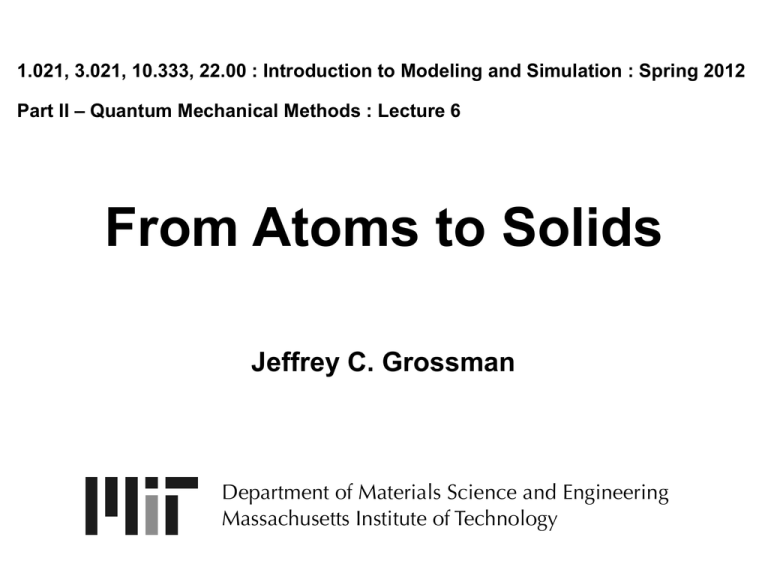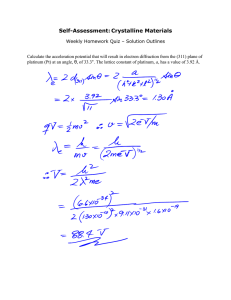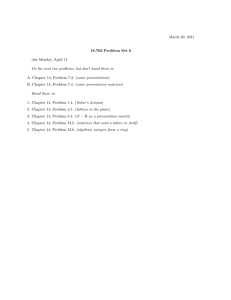
1.021, 3.021, 10.333, 22.00 : Introduction to Modeling and Simulation : Spring 2012
Part II – Quantum Mechanical Methods : Lecture 6
From Atoms to Solids
Jeffrey C. Grossman
Department of Materials Science and Engineering
Massachusetts Institute of Technology
Part II Topics
1.
2.
3.
4.
5.
6.
7.
8.
9.
10.
11.
It’s a Quantum World:The Theory of Quantum Mechanics
Quantum Mechanics: Practice Makes Perfect
From Many-Body to Single-Particle; Quantum Modeling of Molecules
Application of Quantum Modeling of Molecules: Solar Thermal Fuels
Application of Quantum Modeling of Molecules: Hydrogen Storage
From Atoms to Solids
Quantum Modeling of Solids: Basic Properties
Advanced Prop. of Materials:What else can we do?
Application of Quantum Modeling of Solids: Solar Cells Part I
Application of Quantum Modeling of Solids: Solar Cells Part II
Application of Quantum Modeling of Solids: Nanotechnology
Lesson outline
• Briefly hydrogen storage
• Periodic potentials
• Bloch’s theorem
• Energy bands
Hydrogen Storage
Images in the public domain.
President Bush Launches the
Hydrogen Fuel Initiative
"Tonight I am proposing $1.2 billion in research funding so that
America can lead the world in developing clean, hydrogenpowered automobiles.
"A simple chemical reaction between hydrogen and oxygen
generates energy, which can be used to power a car producing
only water, not exhaust fumes.
"With a new national commitment, our scientists and engineers
will overcome obstacles to taking these cars from laboratory to
showroom so that the first car driven by a child born today
could be powered by hydrogen, and pollution-free.
"Join me in this important innovation to make our air
significantly cleaner, and our country much less dependent on
foreign sources of energy."
2003 State of the Union Address
January 28, 2003
From Patrovic & Milliken (2003)
Images are in the public domain.
© Sebastian Blanco/AutoBlogGreen.com. All rights reserved. This content is excluded from our
Creative Commons license. For more information, see http://ocw.mit.edu/help/faq-fair-use/.
A History of Hydrogen as a Fuel
Chemical Reviews, 2004,Vol. 104, No. 3, Grochala and Edwards
© ACS Publications. From: Grochala, W., and Peter P. Edwards. &KHPLFDO5HYLHZV 104 (2004): 1283-1315. All rights reserved.
This content is excluded from our Creative Commons license. For more information, see http://ocw.mit.edu/help/faq-fair-use/.
The Hydrogen Fuel Challenge
• The low volumetric density of gaseous fuels requires
a storage method which densifies the fuel.
• This is particularly true for hydrogen because of its lower energy density
relative to hydrocarbon fuels
• 3 MJ/l (5000 psi H2), 8 MJ/l (LH2) vs. 32 MJ/l (gasoline)
• Storing enough hydrogen on vehicles to achieve
greater than 300 miles driving range is difficult.
• Storage system adds an additional weight and volume
above that of the fuel.
How do we achieve adequate stored energy in an efficient,
safe and cost-effective system?
How large of a gas tank do you want?
Volume Comparisons for 4 kg Vehicular H2 Storage
Schlapbach & Züttel, Nature, 15 Nov. 2001
© Toyota Motor Corporation. All rights reserved. This content is excluded from our Creative Commons license. For more information, see http://ocw.mit.edu/fairuse.
Compressed/Liquid Hydrogen Storage
© EDO Canada. All rights reserved. This content is excluded from our Creative Commons license. For more information, see http://ocw.mit.edu/help/faq-fair-use/.
Packaging volume and safety are key issues
Chemical H-Storage
•Only the light
elements.
•Short list: Li, Be,
B, C, N, O, F, Na,
Mg, Al, Si, and P.
•No toxicity!
•List becomes
only eight
elements.
•Not a lot of
room to do
chemistry!
Chemical Reviews, 2004,Vol. 104, No. 3, Grochala and Edwards
© ACS Publications. From: Grochala, W., and Peter P. Edwards. Chemical Reviews 104 (2004): 1283-1315. All rights reserved. This
content is excluded from our Creative Commons license. For more information, see http://ocw.mit.edu/help/faq-fair-use/.
Lots of Materials Choices
Crystalline Nanoporous Materials
Polymer Microspheres
Self-Assembled Nanocomposites
Advanced Hydrides
Inorganic – Organic Compounds
BN Nanotubes
Hydrogenated Amorphous Carbon
Mesoporous Materials
Bulk Amorphous Materials (BAMs)
Iron Hydrolysis
Nanosize Powders
Metallic Hydrogen
Hydride Alcoholysis
From Patrovic & Milliken (2003)
Lots of Materials Choices
Formula
Formula wt.% Hydrogen
CH4
25
H3BNH3
19.5
LiBH4
18.3
(CH3)4NBH4
18
NH3
17.7
Al(BH4)3
16.8
Mg(BH4)2
14.8
LiH
12.6
CH3OH
12.5
H 2O
11.2
LiAlH4
10.6
NaBH4
10.6
AlH3
10.0
MgH2
7.6
NaAlH4
7.4
Example: BN Nanotubes
Figure 1 The morphologies of BN nanotubes: (a) multiwall nanotubes
and (b) bamboo-like nanotubes. Scale bar: 100 nm.
Figure 2 The hydrogen adsorption as a function of pressure in multiwall BN nanotubes and
bamboo nanotubes at 10 MPa is 1.8 and 2.6 wt %, respectively, in sharp contrast to the
0.2 wt % in bulk BN powder. The values reported here have an error of <0.3 wt %.
Figures removed due to copyright restrictions.
R. Ma, Y. Bando, H.Zhu, T. Sato, C. Xu, and D. Wu, “Hydrogen Uptake in Boron
Nitride Nanotubes at Room Temperature”, J. Am. Chem. Soc., 124, 7672-7673 (2002).
Example: NaAl
NaAlH4
Images of sodium alanate © Sandia/U.S. Dept. of Energy. All rights reserved. This content is excluded
from our Creative Commons license. For more information, see http://ocw.mit.edu/help/faq-fair-use/.
Sodium alanate doped with Ti is a reversible material hydrogen storage approach.
3NaAlH4
Na3AlH6 + 2Al + 3H2
3.7 wt%
3NaH + Al + 3/2H2
1.8 wt%
Low hydrogen capacity and slow kinetics are
issues
Metal Hydrides
•Some metals absorb hydrogen to form metal hydrides
•These release the hydrogen gas when heated at low pressure and
relatively high temperature
•Thus the metals soak up and release hydrogen like a sponge
•Hydrogen becomes part of the chemical structure of the metal itself
and therefore does not require high pressures or cryogenic
temperatures for operation
BUT: irreversibility problem!
Image removed due to copyright restrictions. Table 1 From: Grochala, W., and Peter P. Edwards. Chemical Reviews 104 (2004): 1283-315.
Chemical Reviews, 2004,Vol. 104, No. 3, Grochala and Edwards
There is no ONE material yet.
•There is, as yet, no material known to meet simultaneously all of the
key requirements and criteria.
•Palladium metal has long been viewed as an attractive hydrogenstorage medium, exhibiting reversible behavior at quite low
temperature. However, its poor storage efficiency (less than 1 wt %)
and the high cost of palladium ($1000 per ounce) eliminate it from
any realistic consideration
•On the other hand, the composite material “Li3Be2H7” is a highly
efficient storage medium (ca. 8.7 wt % of reversibly stored H), but it
is highly toxic and operates only at temperatures as high as 300 °C.
There is no ONE material yet.
•Or take AlH3: the compound is a relatively low temperature (150
°C), highly efficient (10.0 wt %) storage material and contains cheap
Al metal ($1300 per tonne), but, unfortunately, its hydrogen uptake is
almost completely irreversible.
•Similarly, an alkaline solution of NaBH4 in H2O constitutes a superefficient storage system (9.2 wt % hydrogen), and full control may be
gained over H2 evolution by use of a proper catalyst, but the starting
material cannot be simply (economically) regenerated.
•Finally, pure water contains 11.1 wt % of H, but its decomposition
requires much thermal, electric, or chemical energy.
•Recently advanced technology of hydrogen storage in nitrides and
imides allows for effective (6.5-7.0 wt % H) but high- temperature
(around 300 °C) storage.
PERFECT Problem for Computa8onal
Quantum Mechanics!
• Hydrogen storage: store hydrogen in a lightweight and compact
manner for mobile applications.
• Bulk materials are often too stable.
• E.g. MgH2: 7.7wt%, ΔH0d = 75 kJ/mol, Td ~ 300 oC
• Desirable ΔH0d = 20 − 50 kJ/mol
• ΔH0d can be tuned by the size of nanoparticles.
Image is in the public domain.
80
bulk
!H (kJ/mol H2)
MgH2
60
40
HF (Wagesmans, et al., 2005)
DFT-B97 (Wagemans, et al., 2005)
DFT-PW91 (Wang & Johnson, 2008)
DFT-PBE
QMC-DMC
Expt.: bulk
20
0
-20
0
10
20
30
40
Bulk
(MgH2)N
Wu, Allendorf, and JCG, JACS (2009)
© 2009 Annual Progress Report, DOE Hydrogen Program. All rights reserved.
This content is excluded from our Creative Commons license. For more
information, see http://ocw.mit.edu/help/faq-fair-use/.
Alloying and Nanostructuring May be
the Key, but Phase Space is Enormous
© RSC Publishing. From Physical Chemistry Chemical Physics 14 (2012): 6611–16. All rights reserved. This content is
excluded from our Creative Commons license. For more information, see http://ocw.mit.edu/help/faq-fair-use/.
Wagner, Allendorf, and JCG, PCCP (2012)
From Atoms to Solids
?
From atoms to solids
Atom
Molecule
Solid
Energy
Antibonding p
Conduction band
from antibonding
p orbitals
Antibonding s
Conduction band
from antibonding
s orbitals
p
s
Bonding p
Bonding s
Valence band from
p bonding orbitals
Valence band from
s bonding orbitals
k
Image by MIT OpenCourseWare.
The ground state electron configuration of a system is constructed by putting the
available electrons, two at a time (Pauli principle), into the states of lowest energy
Energy bands
empty
Energy
energy
gap
occupied
Metal
Insulator
Semiconductor
NB: boxes = allowed energy regions
Crystal symmetries
A crystal is built up
of a unit cell and
periodic replicas thereof.
lattice
unit cell
Image of Sketch 96 (Swans) by M.C. Escher removed due to copyright restrictions.
Crystal symmetries
crystal/solid
1023 particles
per cm3
Since a crystal is periodic, maybe we can get away
with modeling only the unit cell?
Crystal symmetries
S = simple
BC = body centered
FC = face centered
© Sandeep Sangal/IITK. All rights reserved. This content is excluded from our Creative
Commons license. For more information, see http://ocw.mit.edu/help/faq-fair-use/.
Lattice and basis
simple
cubic
basis
face
centered
cubic
Images by MIT OpenCourseWare.
The inverse
(or “reciprocal”) lattice
Associated with each real space lattice, there exists
something we call a reciprocal lattice.
The reciprocal lattice is the set of wave-vectors which
are commensurate with the real space lattice.
It is defined by a set of vectors a*, b*, and c* such that
a* is perpendicular to b and c of the Bravais lattice, and
the product a* x a is 1.
The inverse lattice
The real space lattice is described by three basis vectors:
⌅ = n1⌅
a1 + n2⌅
a2 + n3⌅
a3
R
The inverse lattice is described by three basis vectors:
⌅ = m1⌅b1 + m2⌅b2 + m3⌅b3
G
⌅ R
⌅
iG·
e
=1
(⇧
r) =
⇧ j ·⇧
iG
r
cj e
j
automatically periodic in R!
The inverse lattice
real space lattice (BCC)
inverse lattice (FCC)
z
a
a1
a2
x
a3
y
Image by MIT OpenCourseWare.
The Brillouin zone
inverse lattice
The Brillouin zone is a special
unit cell of the inverse lattice.
Image by Gang65 on Wikimedia Commons. License: CC-BY-SA. This content is excluded from our
Creative Commons license. For more information, see http://ocw.mit.edu/help/faq-fair-use/.
Reciprocal Lattice
& Brillouin Zone
It is defined by a set of vectors a*, b*, and c* such that a*
is perpendicular to b and c of the Bravais lattice, and the
product a* x a is 1.
b×c
In particular: a =
a⋅b×c
*
Image is in the public domain.
Brillouin
b×c
a =
a⋅b×c
*
€
© R. Nave. All rights reserved. This content is excluded
from our Creative Commons license. For more
information, see http://ocw.mit.edu/help/faq-fair-use/.
Surfaces of the first, second, and third Brillouin zones
for body-centered cubic and face-centered cubic
crystals. Images are in the public domain.
The Brillouin zone
Brillouin zone of the FCC lattice
Periodic potentials
metallic sodium
V (⇤
r)
⇥
R
⇥
R
⇥
R
.
n
2m
⇥
2
r) 1 = E1
⇥ + V (⌃
© Prof. Dr. Helmut Föll. All rights reserved. This content is excluded from our Creative
Commons license. For more information, see http://ocw.mit.edu/fairuse.
Periodic potentials
It becomes much easier if you use the
periodicity of the potential!
lattice vector
⌅)
V (⌅
r ) = V (⌅
r+R
Results in a VERY
important new concept.
Bloch’s Theorem
Bloch’s Theorem
Reciprocal lattice vectors have special properties of
particular value for calculations of solids.
We write the reciprocal lattice vector:
G = 2πna + 2πmb + 2πoc
*
*
*
We added the 2 simply for convenience, and the n, m,
o, are integers.
€
Now consider the behavior of the function exp(iGr).
Bloch’s Theorem
exp(iG⋅ r) = exp[i(2πna + 2πmb + 2πoc )⋅ (αa + βb + γc)]
*
*
*
= exp[i(2πnα + 2πmβ + 2πoγ )]
= cos(2πnα + 2πmβ + 2πoγ ) + isin(2πnα + 2πmβ + 2πoγ )
As r is varied, lattice vector coefficients (α,β,γ) change
between 0 and 1 and the function exp(iG·r) changes too.
However, since n, m, and o are integral, exp(iG·r) will
always vary with the periodicity of the real-space lattice.
⌅ R
⌅
iG·
e
=1
(⇧
r) =
⇧ j ·⇧
iG
r
cj e
j
automatically periodic in R!
Bloch’s Theorem
The periodicity of the lattice in a solid means that the
values of a function (e.g., density) will be identical at
equivalent points on the lattice.
The wavefunction, on the other hand, is periodic but
only when multiplied by a phase factor.
This is known as Bloch’s theorem.
NEW quantum number k that
lives in the inverse lattice!
r)
⌅
k (⇧
=e
i⌅
k·⌅
r
u⌅k (⇧
r)
⌅)
u⇥k (⌅
r ) = u⇥k (⌅
r+R
Periodic potentials
Results of the Bloch theorem:
⇧) =
(
⇧
r
+
R
⌅
k
r )e
⌅
k (⇧
⌅ ⌅
ik·R
Courtesy Stanford News Service.
License CC-BY.
2
⌅
| ⇥k (⌅
r + R)| = |
if solution
l⇤k (⇤
r)
with
r )|
⇥
k (⌅
⇥ l⇤k+G
r)
⇤ (⇤
E⇤k = E⇤k+G
⇤
2
charge density
is lattice periodic
also solution
Periodic potentials
Schrödinger
equation
certain
symmetry
hydrogen
atom
spherical
symmetry
[H, L2 ] = HL2
quantum
number
r)
n,l,m (⇤
L2 H = 0
[H, Lz ] = 0
periodic
solid
translational
symmetry
[H, T ] = 0
r)
n,⌅
k (⇤
Periodic potentials
ψk (r) = eik.r
λ = 2π/k
Bloch’s theorem
r)
⌅
k (⇧
=e
i⌅
k·⌅
r
u⌅k (⇧
r)
⌅)
u⇥k (⌅
r ) = u⇥k (⌅
r+R
u(r)
a
k=0
k = π/a
Image by MIT OpenCourseWare.
The band structure
Different wave functions can satisfy the Bloch theorem for the same k:
eigenfunctions and eigenvalues labelled with k and the index n
energy bands
The band structure
Silicon
6
E (eV)
G15
G'25
0
EC
EV
X1
S1
-10
energy levels
in the Brillouin zone
G1
Figure by MIT OpenCourseWare.
L
L
G
D
X
U,K
S
G
k
Image by MIT OpenCourseWare.
The band structure
Silicon
6
unoccupied
G
E (eV)
15
G'25
0
S1
EC
EV
X1
occupied
-10
energy levels
in the Brillouin zone
G1
Figure by MIT OpenCourseWare.
L
L
G
D
k
X
U,K
S
G
Image by MIT OpenCourseWare.
Literature
• Charles Kittel, Introduction to Solid State
Physics
• Richard M. Martin, Electronic Structure
• wikipedia,“solid state physics”,“condensed
matter physics”, ...
• Simple band structure simulations: http://
phet.colorado.edu/simulations/sims.php?
sim=Band_Structure
MIT OpenCourseWare
http://ocw.mit.edu
3.021J / 1.021J / 10.333J / 18.361J / 22.00J Introduction to Modelling and Simulation
Spring 2012
For information about citing these materials or our Terms of Use, visit: http://ocw.mit.edu/terms.



